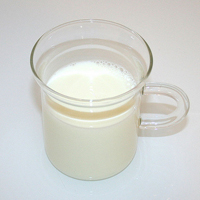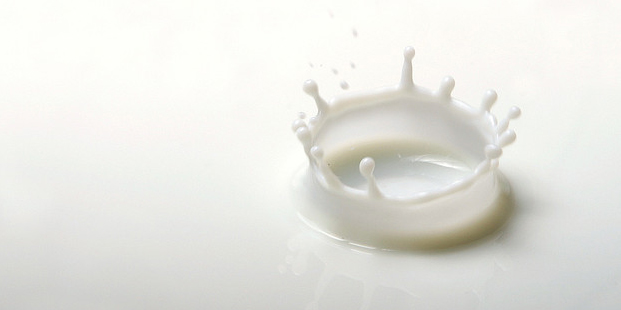The future of milk
Milk is expensive. Not so much in terms of the cost at the supermarket, but in terms of the environmental cost. The white stuff is, therefore, hardly green. Synthetic milk could help avoid this downside. The environmental benefits would be substantial indeed – but the social and political consequences could be far-reaching.
Large areas of land are intensively cultivated as pasture to feed highly bred cows that produce enormous amounts of milk every day. Farmers use huge quantities of fertiliser to maintain the lush grass that cows need to maintain milk production. And as if this weren’t enough, soy – grown extensively where tropical forests once stood – is a major component of cattle feed. Moreover, the methane that dairy cows emit has an impact on global warming that is between 20 to 25 times that of an equivalent amount of CO2.
Artificially produced milk
In light of all this, you would think we should welcome the development of synthetic milk that avoids these environmental costs. This milk would not be produced by a cow on a green field, but by a lab on an industrial estate. And yes, it seems possible to do this [1].

Basically, milk consists of proteins and fats. To make milk proteins, all researchers need to do is convert the amino acid sequence of each of the six milk proteins into a DNA sequence, then integrate the DNA sequence into yeast cells. The yeast then starts producing milk proteins. Now just add some water and the aromatic fatty acids that give milk its flavour, and we have milk!
Synthetic milk can be lactose-free – benefiting the 75% of the world’s population that cannot digest it – and also free of cholesterol. It requires no pasteurisation and no refrigeration. An enterprising little company called Muufri is already developing what it calls ‘animal-free milk’ [2].
Environmental benefits
Let’s imagine, for one moment, that synthetic milk production can be readily and cost-effectively expanded to meet the global milk demand. Let’s also assume that consumers are quite happy to drink milk produced by scientists and yeast. No longer will we need land for pastures or to grow cattle feed, nor do we need to apply fertilisers to improve grasslands. Neither do we need to administer drugs or antibiotics to maintain the health of the dairy herd, or hormones to boost their production. We can avoid the 100 million tonnes of methane that dairy cows produce annually. The environmental benefits would be very great, indeed.
Disruptive impacts on European dairy industry
So far so good, but environmental issues are also social issues. There are over 1 million dairy farms in the European Union. A potential success of synthetic milk would threaten all of these farms, many of which are already struggling. As it is, the Common Agricultural Policy – the mechanism that subsidises European farmers – accounts for 40% of the EU’s budget. This means 57 billion euros out of a total EU budget of 133 billion euros, 3.5 billion euros of which are direct payments for the milk sector alone. Would the political will to maintain such subsidies survive a collapsing market?
If not, the social and political consequences of synthetic milk could be immense. The collapsing viability of dairy farms would lead to job losses on the 1 million dairy farms and in the wider dairy industry, which employs a further 400,000 people. Farms would be abandoned and landscapes would change in structure and composition. Tensions among the rural populations would increase. Widespread protests by dairy farmers against the phasing out of EU milk quotas by 2015 have already provided a small indication of the possible repercussions.
Drawbacks and questions for Switzerland
In Switzerland dairy farming is integral to the ecological structure and cultural identity of the Alpine region, where 28% of Swiss farms are located, including many of its family-run dairy farms. In total there are some 590,000 dairy cows on 32,000 farms, that is to say 70% of all farms in Switzerland (2011 Federal Statistical Office figures, [3]). Government subsidies, which already account for around 50% of dairy farm income, seek to maintain a degree of self-sufficiency in milk products and recognise the importance of farming to conserving the landscape, maintaining rural culture, and avoiding rural depopulation. Would subsidising dairy farmers still make sense even if the market for their product were to dry up? Would it make sense to reallocate subsidies to land-management objectives to maintain a cultural landscape? And if not, would the Swiss nation be prepared to see large swathes of Alpine pasture revert to scrub and forest, with implications this would have for biodiversity, cultural history and tourism? And what would happen to all those locally produced cheeses?
These are all tough questions for which I have no immediate answer. Needless to say, it may prove too difficult to upscale synthetic milk production to the quantities needed, or the process might not be economically viable. Even if it turns out to be possible, we consumers might still favour milk produced by cows. Nonetheless, it is worth bearing in mind that apparent solutions to environmental problems often have much wider social and political repercussions. We ignore these at our peril.
References
[1] New Scientist, 30 June 2014, issue 2975: “Don't have a cow: Making milk without the moo” by Ryan Pandya
[2] external pageMuufricall_made
[3] external pageStudycall_made: From grass to milk production in Switzerland

